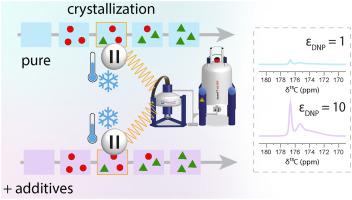Solid State Nuclear Magnetic Resonance ( IF 1.8 ) Pub Date : 2022-10-23 , DOI: 10.1016/j.ssnmr.2022.101836 Marie Juramy 1 , Paolo Cerreia Vioglio 1 , Fabio Ziarelli 2 , Stéphane Viel 3 , Pierre Thureau 1 , Giulia Mollica 1

|
Crystallization is fundamental in many domains, and the investigation of the sequence of solid phases produced as a function of crystallization time is thus key to understand and control crystallization processes. Here, we used a solid-state nuclear magnetic resonance strategy to monitor the crystallization process of glycine, which is a model compound in polymorphism, under the influence of crystallizing additives, such as methanol or sodium chloride. More specifically, our strategy is based on a combination of low-temperatures and dynamic nuclear polarization (DNP) to trap and detect transient crystallizing forms, which may be present only in low quantities. Interestingly, our results show that these additives yield valuable DNP signal enhancements even in the absence of glycerol within the crystallizing solution.
中文翻译:

用动态核极化固态核磁共振监测添加剂对甘氨酸结晶过程的影响
结晶是许多领域的基础,因此研究作为结晶时间函数产生的固相序列是理解和控制结晶过程的关键。在这里,我们使用固态核磁共振策略来监测甘氨酸的结晶过程,甘氨酸是多晶型中的模型化合物,在结晶添加剂(如甲醇或氯化钠)的影响下。更具体地说,我们的策略是基于低温和动态核极化 (DNP) 的组合来捕获和检测可能仅存在少量的瞬态结晶形式。有趣的是,我们的结果表明,即使在结晶溶液中不存在甘油的情况下,这些添加剂也会产生有价值的 DNP 信号增强。






























 京公网安备 11010802027423号
京公网安备 11010802027423号